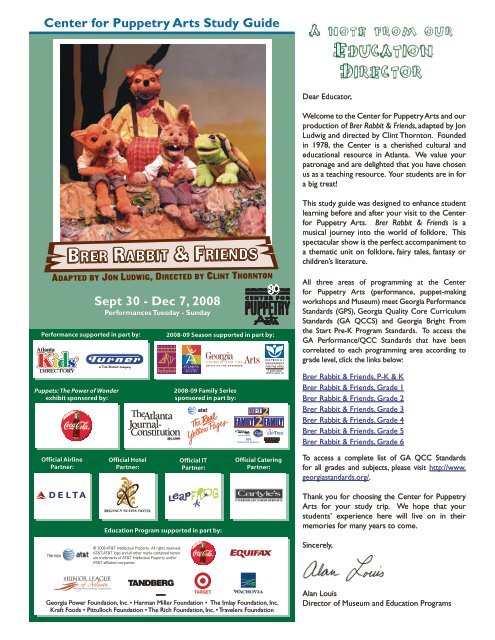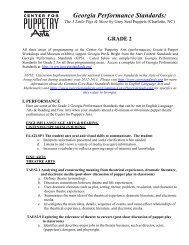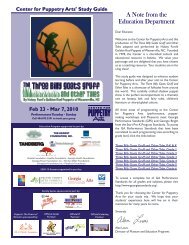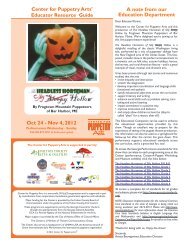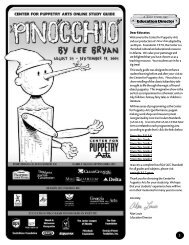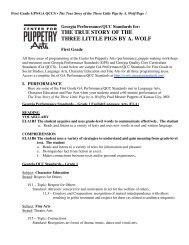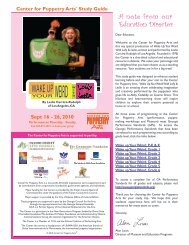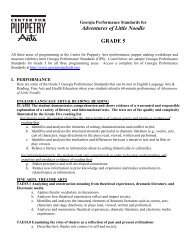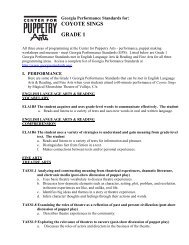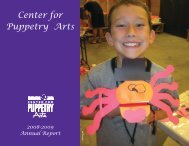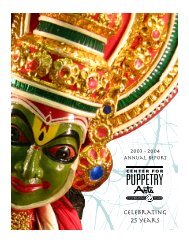Brer Rabbit & Friends - Center for Puppetry Arts
Brer Rabbit & Friends - Center for Puppetry Arts
Brer Rabbit & Friends - Center for Puppetry Arts
You also want an ePaper? Increase the reach of your titles
YUMPU automatically turns print PDFs into web optimized ePapers that Google loves.
IN YOUR LIFE. OFF YOUR MIND.<br />
<strong>Center</strong> <strong>for</strong> <strong>Puppetry</strong> <strong>Arts</strong> Study Guide<br />
A note from our<br />
Education<br />
Director<br />
Dear Educator,<br />
Welcome to the <strong>Center</strong> <strong>for</strong> <strong>Puppetry</strong> <strong>Arts</strong> and our<br />
production of <strong>Brer</strong> <strong>Rabbit</strong> & <strong>Friends</strong>, adapted by Jon<br />
Ludwig and directed by Clint Thornton. Founded<br />
in 1978, the <strong>Center</strong> is a cherished cultural and<br />
educational resource in Atlanta. We value your<br />
patronage and are delighted that you have chosen<br />
us as a teaching resource. Your students are in <strong>for</strong><br />
a big treat!<br />
This study guide was designed to enhance student<br />
learning be<strong>for</strong>e and after your visit to the <strong>Center</strong><br />
<strong>for</strong> <strong>Puppetry</strong> <strong>Arts</strong>. <strong>Brer</strong> <strong>Rabbit</strong> & <strong>Friends</strong> is a<br />
musical journey into the world of folklore. This<br />
spectacular show is the perfect accompaniment to<br />
a thematic unit on folklore, fairy tales, fantasy or<br />
children’s literature.<br />
Per<strong>for</strong>mance supported in part by:<br />
Sept 30 - Dec 7, 2008<br />
Per<strong>for</strong>mances Tuesday - Sunday<br />
2008-09 Season supported in part by:<br />
All three areas of programming at the <strong>Center</strong><br />
<strong>for</strong> <strong>Puppetry</strong> <strong>Arts</strong> (per<strong>for</strong>mance, puppet-making<br />
workshops and Museum) meet Georgia Per<strong>for</strong>mance<br />
Standards (GPS), Georgia Quality Core Curriculum<br />
Standards (GA QCCS) and Georgia Bright From<br />
the Start Pre-K Program Standards. To access the<br />
GA Per<strong>for</strong>mance/QCC Standards that have been<br />
correlated to each programming area according to<br />
grade level, click the links below:<br />
Puppets: The Power of Wonder<br />
exhibit sponsored by:<br />
2008-09 Family Series<br />
sponsored in part by:<br />
<strong>Brer</strong> <strong>Rabbit</strong> & <strong>Friends</strong>, P-K & K<br />
<strong>Brer</strong> <strong>Rabbit</strong> & <strong>Friends</strong>, Grade 1<br />
<strong>Brer</strong> <strong>Rabbit</strong> & <strong>Friends</strong>, Grade 2<br />
<strong>Brer</strong> <strong>Rabbit</strong> & <strong>Friends</strong>, Grade 3<br />
<strong>Brer</strong> <strong>Rabbit</strong> & <strong>Friends</strong>, Grade 4<br />
<strong>Brer</strong> <strong>Rabbit</strong> & <strong>Friends</strong>, Grade 5<br />
<strong>Brer</strong> <strong>Rabbit</strong> & <strong>Friends</strong>, Grade 6<br />
Official Airline<br />
Partner:<br />
Official Hotel<br />
Partner:<br />
Official IT<br />
Partner:<br />
Official Catering<br />
Partner:<br />
To access a complete list of GA QCC Standards<br />
<strong>for</strong> all grades and subjects, please visit http://www.<br />
georgiastandards.org/.<br />
Education Program supported in part by:<br />
© 2008 AT&T Intellectual Property. All rights reserved.<br />
AT&T, AT&T logo and all other marks contained herein<br />
are trademarks of AT&T Intellectual Property and/or<br />
AT&T affiliated companies.<br />
Thank you <strong>for</strong> choosing the <strong>Center</strong> <strong>for</strong> <strong>Puppetry</strong><br />
<strong>Arts</strong> <strong>for</strong> your study trip. We hope that your<br />
students’ experience here will live on in their<br />
memories <strong>for</strong> many years to come.<br />
Sincerely,<br />
Georgia Power Foundation, Inc. • Herman Miller Foundation • The Imlay Foundation, Inc.<br />
Kraft Foods • Pittulloch Foundation • The Rich Foundation, Inc. • Travelers Foundation<br />
Alan Louis<br />
Director of Museum and Education Programs
Synopsis<br />
Brains beat brawn when <strong>Brer</strong> Bear, <strong>Brer</strong> Fox, <strong>Brer</strong> <strong>Rabbit</strong>, and Sister Mud Turtle find themselves in a briar patch of trouble!<br />
The day gets off to a rousing start with a jam session of live banjo, piano and tambourine when the gang gathers to sing<br />
an early morning ode to the day. As the day passes, our colorful friends act out the stories of “<strong>Brer</strong> <strong>Rabbit</strong>’s Laffin’ Place,”<br />
“How the Bear Got His Tail,” “Sister Mud Turtle Shows Her Strength,” “<strong>Brer</strong> Fox Plays Dead,” “<strong>Brer</strong> <strong>Rabbit</strong> Scares <strong>Brer</strong><br />
Fox and <strong>Brer</strong> Bear” and finally, “The Wonderful Tar Baby.” These delightful stories illustrate classic standoffs between the<br />
weak and the powerful that are a part of every culture’s folklore.<br />
About the Stories<br />
Joel Chandler Harris (1845-1908) was born in Eatonton, Georgia, and<br />
was raised by his single mother. He grew up very poor. When he was 14<br />
he became a printer’s assistant on a plantation so large that it published<br />
its own newspaper. On the plantation, Harris was introduced to African-<br />
Americans who were <strong>for</strong>ced to work as slaves. He befriended two elderly<br />
slaves, George Terrell and “Old Harbert”, who entertained him with<br />
folktales of <strong>Brer</strong> <strong>Rabbit</strong> and <strong>Brer</strong> Fox. Many of these tales were retellings<br />
of West African trickster stories, featuring Anansi the Spider, that had<br />
been passed down <strong>for</strong> generations. Harris had an ear <strong>for</strong> the dialect in<br />
which the men spoke and recorded the stories exactly as they were<br />
spoken at the time. Like the Brothers Grimm, Harris did not invent the<br />
stories he published, but dedicated himself to documenting an important<br />
oral tradition <strong>for</strong> posterity. The result was the single largest collection<br />
of African-American folktales ever published. His first collection of<br />
poems and proverbs was published in 1881 as Uncle Remus: His Songs<br />
and Sayings. (Harris created the fictitious character “Uncle Remus” who<br />
served as the narrator of his books.) A contemporary of Mark Twain,<br />
Harris also worked as a newspaper writer and editor. Harris lived in his<br />
Atlanta home, The Wren’s Nest, from 1881 until his death in 1908.<br />
Style of <strong>Puppetry</strong><br />
<strong>Brer</strong> <strong>Rabbit</strong> & <strong>Friends</strong> is per<strong>for</strong>med by five skilled puppeteers using a variety of puppetry styles. As students will observe,<br />
certain types of puppets work best <strong>for</strong> certain types of characters. One type of puppet used in our show is a hand-and-rod<br />
puppet. <strong>Brer</strong> <strong>Rabbit</strong> and <strong>Brer</strong> Fox are examples of hand-and-rod puppets. A puppeteer operates a hand-and-rod puppet by<br />
placing one hand inside the head of the puppet to turn the puppet’s head and operate its mouth. A puppeteer opens and<br />
closes that hand to make the puppet’s mouth move as she/he provides the character’s voice. This is known as lip-synching.<br />
The puppeteer’s other hand operates the control rods attached to the puppet’s hands (or paws). Our puppeteers per<strong>for</strong>m<br />
their hand-and-rod puppets from behind a low wall known as a playboard. Seated on low rolling carts, the puppeteers<br />
stretch their arms above their heads to per<strong>for</strong>m the puppets in the lighted playing area on top of the playboard.<br />
You will also notice shadow puppets in our production – projections of the 3D puppets, hand shadows and painted<br />
plexiglass. They are per<strong>for</strong>med either on an overhead projector or in an “alley” between a shadow screen and a very bright<br />
halogen bulb. This way, the silhouette image that the puppeteers create on the shadow screen can be much larger than<br />
the actual puppet itself. A shadow puppet of Sister Mud Turtle is used in the scene where she swims to the bottom of<br />
the pond.<br />
In order to bring their characters to life, the puppeteers in our show sometimes appear in special costumes. <strong>Brer</strong> Bear is<br />
an example of a costumed puppeteer. All of the character voices and animal sounds are per<strong>for</strong>med live by the cast. Each<br />
puppeteer wears a cordless microphone to amplify her/his voice.<br />
© 2008 <strong>Center</strong> <strong>for</strong> <strong>Puppetry</strong> <strong>Arts</strong>. All Rights Reserved.<br />
Joel Chandler Harris<br />
2
Bibliography<br />
• Badoe, Adwoa. The Pot of Wisdom: Ananse Stories. Broundwood/Douglas & McIntyre, 2001.<br />
• Doucet, Sharon Arms. Lapin Plays Possum: Trickster Tales from the Louisiana Bayou. Farrar,<br />
Straus and Giroux, 2002.<br />
• Harris, Joel Chandler. Uncle Remus and <strong>Brer</strong> <strong>Rabbit</strong>. Applewood Books (Reprint), 1999.<br />
• Harris, Joel Chandler. Wally Wonderoon and his Story Telling Machine. McClure, Phillips & Co., 1903.<br />
• Harris, Joel Chandler & Keenan, Hugh T. Dearest Chums and Partners: Joel Chandler Harris’s Letters to<br />
His Children: A Domestic Biography. University of Georgia Press, 1993.<br />
• Harris, Julia F. The Life and Letters of Joel Chandler Harris. Reprint Services Corp., 1992.<br />
• Kimmel, Eric A. Anansi and the Magic Stick. Holiday House, 2002.<br />
• McDermott, Gerald. Anansi the Spider: A Tale from the Ashanti. Henry Holt and Co., 1987.<br />
• McDermott, Gerald. Zomo the <strong>Rabbit</strong>: A Tale from West Africa. Voyager Books, 1996.<br />
• Sherman, Josepha. Trickster Tales: Forty Folk Stories from Around the World. August House Publishers, 1996.<br />
• Ross, Gayle. How <strong>Rabbit</strong> Tricked Otter and Other Cherokee Trickster Stories. Parabola Books, 2003.<br />
Internet Resources<br />
http://wrensnestonline.com/<br />
By preserving the legacy of Joel Chandler Harris and the heritage of African-<br />
American folklore through storytelling, tours and special events, the Wren’s<br />
Nest serves as an educational resource and entertainment venue <strong>for</strong> the<br />
community, the greater Atlanta area and visitors from around the globe.<br />
http://www.planetozkids.com/oban/Home/home.html<br />
Visit the Animals, Myths and Legends website to read amazing animal stories.<br />
http://www.uncleremus.com/museum.html<br />
Contact in<strong>for</strong>mation and a map to the Uncle Remus Museum in Eatonton, GA.<br />
http://songofthesouth.net/home.html<br />
A fan site <strong>for</strong> Walt Disney’s 1946 film Song of the South.<br />
http://www.ferrum.edu/applit/<br />
Read Caribbean versions of West African Ananse stories.<br />
http://www.sacred-texts.com/afr/mlb/mlb19.htm<br />
Read “<strong>Brer</strong> <strong>Rabbit</strong> in Africa” which provides background in<strong>for</strong>mation as well as folktales at the Internet<br />
Sacred Text Archive.<br />
http://www.pitt.edu/~dash/folktexts.html<br />
A comprehensive database of Folklore and Mythology Electronic Texts.<br />
http://www.folkart.com/folktale<br />
Read Mayan folktales such as “The <strong>Rabbit</strong> and the Coyote” and “The Jaguar and the Little Skunk.”<br />
© 2008 <strong>Center</strong> <strong>for</strong> <strong>Puppetry</strong> <strong>Arts</strong>. All Rights Reserved.<br />
3
Learning Activities<br />
P-K & K: Make a Favorite Folktales Bar Graph<br />
Georgia Bright from the Start Pre-K Content Standards covered: Mathematical Development,<br />
MD 3 f (Participates in creating and using real and pictorial graphs or other simple representations<br />
of data); Language and Literacy Development, LD 5 d (Associates symbols with objects, concepts and<br />
functions. Georgia Per<strong>for</strong>mance Standards covered: Kindergarten, Mathematics, Data Analysis<br />
and Probability MKD1; English Language <strong>Arts</strong>, Comprehension ELAKR6a.<br />
Objective: Students will choose their favorite folktale from those per<strong>for</strong>med in <strong>Brer</strong> <strong>Rabbit</strong> & <strong>Friends</strong> to<br />
construct a class bar graph.<br />
Materials: Folktale images (see reproducible sheet on next page), a marker <strong>for</strong> the teacher, crayons or<br />
markers <strong>for</strong> students, tape, and chart paper.<br />
Procedure:<br />
1. Have students recall the following four stories from the <strong>Center</strong> <strong>for</strong> <strong>Puppetry</strong> <strong>Arts</strong>’ production<br />
of <strong>Brer</strong> <strong>Rabbit</strong> & <strong>Friends</strong>: “Why the Bear Has No Tail,” “Sister Mud Turtle Shows Her Strength,”<br />
“<strong>Brer</strong> <strong>Rabbit</strong> Scares <strong>Brer</strong> Fox and <strong>Brer</strong> Bear” and “<strong>Brer</strong> Fox Plays Dead.”<br />
2. Make a copy of the Folktale Images Sheet (see next page) <strong>for</strong> each student. Have students color<br />
and cut out each picture.<br />
3. Post a sheet or two of chart paper on the board (or on an easel) in front of the classroom.<br />
Divide the paper into four rows or columns (bar graph can be vertical or horizontal). Title your<br />
graph and label each row or column with a story title.<br />
4. Ask students to choose the image that represents their favorite story and put a piece of tape on<br />
the back of it. Have each student come up to the graph with her/his image and place it on the<br />
corresponding row or column. Adults in the room may also participate.<br />
5. When everyone has placed her/his image on the chart, ask students if they can tell just by<br />
looking at the bar graph which story was the most popular, the second most popular, etc. Are<br />
any two bars on the graph equivalent? Encourage students to use the following comparison<br />
terms: same as, fewer than, more than, etc.<br />
6. Ask students to count the number of images in each row or column, or do this together as a<br />
class. Record the numbers <strong>for</strong> each bar on the graph.<br />
7. Display bar graph in classroom or hallway.<br />
Assessment: Ask each student to compare two or more bars on the graph and describe the<br />
relationship between them. Remediate if necessary.<br />
© 2008 <strong>Center</strong> <strong>for</strong> <strong>Puppetry</strong> <strong>Arts</strong>. All Rights Reserved.<br />
4
Folktale Images Sheet<br />
<strong>Brer</strong> Fox Plays Dead<br />
Why the Bear Has No Tail<br />
<strong>Brer</strong> <strong>Rabbit</strong> Scares<br />
<strong>Brer</strong> Fox & <strong>Brer</strong> Bear<br />
Sister Mud Turtle<br />
Shows Her Strength<br />
© 2008 <strong>Center</strong> <strong>for</strong> <strong>Puppetry</strong> <strong>Arts</strong>. All Rights Reserved.<br />
Illustrations by Anthony Owsley 2008.
Learning Activities<br />
1st & 2nd Grade: <strong>Brer</strong> <strong>Rabbit</strong> Fraction Activity<br />
Georgia Per<strong>for</strong>mance Standards covered: Grade 1, Mathematics, Number and Operations<br />
M1N4c. Grade 2, Mathematics, Number and Operations M2N4a,b.<br />
Objective: Students will relate fractions (halves, thirds, fourths, etc.) to concrete and pictorial models<br />
and relate the models to the fractions.<br />
Materials: Crayons, <strong>Brer</strong> <strong>Rabbit</strong> Fraction Activity handouts (one per student - see next page).<br />
Procedure:<br />
1. Review fractions with students. The numerator tells how much of the total (denominator) is<br />
represented. There<strong>for</strong>e two-thirds can be read “two out of three.”<br />
2. Distribute handouts and crayons.<br />
3. Ask students to color the number of rabbits that will represent the fraction given <strong>for</strong> each group.<br />
For example, since 1/2 represents one out of two, one rabbit should be colored in.<br />
Assessment: Collect student handouts. Review <strong>for</strong> percentage of correct responses. Remediate<br />
if necessary.<br />
Sister Mud Turtle, <strong>Brer</strong> <strong>Rabbit</strong>, <strong>Brer</strong> Fox and <strong>Brer</strong> Bear<br />
on the set of <strong>Brer</strong> <strong>Rabbit</strong> & <strong>Friends</strong><br />
© 2008 <strong>Center</strong> <strong>for</strong> <strong>Puppetry</strong> <strong>Arts</strong>. All Rights Reserved.<br />
6
Name_____________________________________________________ Date_________________________<br />
<strong>Brer</strong> <strong>Rabbit</strong> Fraction Activity<br />
1st & 2nd Grade Activity<br />
Directions: Color the correct number of rabbits<br />
to represent the fraction shown <strong>for</strong> each group.<br />
1/2 2/3<br />
6/6 1/5<br />
© 2008 <strong>Center</strong> <strong>for</strong> <strong>Puppetry</strong> <strong>Arts</strong>. All Rights Reserved.
Learning Activities<br />
3rd & 4th Grade: Write Your Own Trickster Tale<br />
Georgia Per<strong>for</strong>mance Standards covered: Grade 3, English Language <strong>Arts</strong>, Writing<br />
ELA3W1a,b,c,d,e,f,g,h,I, jk, l, m, n; ELA3W2a, b, c, d, e, f, g, h, I, j. Grade 4, English Language <strong>Arts</strong>, Writing<br />
ELA4W1a, b, c, d; ELA4Wa, b, c, d, e, f, g, h.<br />
Objective: Students will write and illustrate a short story about an animal that tricks bigger, stronger<br />
animals to achieve its goals, escape from harm, etc.<br />
Materials: Paper and pencils or computers with word processing software and crayons or markers.<br />
Procedure:<br />
1. Many of the <strong>Brer</strong> <strong>Rabbit</strong> stories recorded by Joel Chandler Harris are actually retellings of Anansi<br />
trickster stories from West Africa. Familiarize your students with <strong>Brer</strong> <strong>Rabbit</strong> & <strong>Friends</strong> at the<br />
<strong>Center</strong> <strong>for</strong> <strong>Puppetry</strong> <strong>Arts</strong> and also some of the Anansi trickster stories (see Bibliography). These<br />
stories illustrate the classic standoffs between the weak and the powerful.<br />
2. Explain to students that the hero of a trickster story is usually a smaller, weaker animal (even an<br />
insect), but because of her/his cleverness, she/he is able to outwit even the most powerful animal.<br />
3. Ask students to choose an animal to be the trickster in a story that they will write.<br />
4. Prewriting – brainstorm possible story ideas. What sort of predicament might their trickster<br />
get into?<br />
5. Drafting – use prewriting ideas to complete first draft.<br />
6. Revising – improve sentences, expand sentence variety, organize to <strong>for</strong>m a clear beginning, middle<br />
and end. The trick that the trickster has achieved should be evident.<br />
7. Editing – check <strong>for</strong> correct spelling, capitalization and punctuation.<br />
8. Publishing – add illustrations and share writing with others.<br />
Assessment: Collect stories <strong>for</strong> writing portfolios.<br />
Sister Mud Turtle, <strong>Brer</strong> Fox and <strong>Brer</strong> Bear in the story<br />
“Sister Mud Turtle Shows Her Strength”<br />
© 2008 <strong>Center</strong> <strong>for</strong> <strong>Puppetry</strong> <strong>Arts</strong>. All Rights Reserved.<br />
8
Learning Activities<br />
5th & 6th Grade: Oral History Preservation Activity<br />
Georgia Per<strong>for</strong>mance Standards covered: Grade 5, English Language <strong>Arts</strong>, Writing ELA5W1a,<br />
b, c, d, e; ELA5W2a, b, c, d, e, f, g (<strong>for</strong> in<strong>for</strong>mational writing). Grade 6, English Language <strong>Arts</strong>, Writing<br />
ELA6W1a, b, c, d; ELA6W2a, b, c, d, e, f, g, h (multi-paragraph expository composition such as description,<br />
explanation, comparison and contrast, or problem and solution); ELA6W4a, b, c.<br />
Objective: Students will record and transcribe an oral history interview with a parent, grandparent or<br />
senior relative.<br />
Materials: Tape recorder, cassette tape, computer with word processing software.<br />
Procedure:<br />
1. Students should find a subject <strong>for</strong> their interview; a grandparent or senior citizen is ideal. The<br />
idea is to capture details and stories from an elder like Joel Chandler Harris did in his books. A<br />
successful oral history is authentic and straight from the interviewee’s mouth.<br />
2. Students should create a list of questions <strong>for</strong> their subject. Open-ended questions such as “Tell<br />
me about how you spent your days when you were a child” or “What was the most exciting<br />
thing that ever happened to you?” will solicit a richer response than a yes/no question like “Did<br />
you like school when you were a child?”<br />
3. Students should conduct their interview and record it on audio tape.<br />
4. Students should then type a transcript of the interview from the cassette tape. This will be time<br />
consuming. Tape will need to be stopped and started frequently. Students should record what<br />
they hear on the tape word <strong>for</strong> word and be careful not to change or omit anything.<br />
5. Students should share their transcripts with their classmates. Do they feel that in<strong>for</strong>mation may<br />
someday have been lost had they not taken the time to conduct their oral history?<br />
Assessment: Collect transcripts and audio tapes to make sure students completed the activity. Does<br />
the transcript appear to be authentic?<br />
<strong>Center</strong> <strong>for</strong> <strong>Puppetry</strong> <strong>Arts</strong> is a non-profit, 501(c)(3) organization and is supported in part by contributions from corporations,<br />
foundations, government agencies, and individuals. Major funding <strong>for</strong> the <strong>Center</strong> is provided by the Fulton County Board of Commissioners under the<br />
guidance of the Fulton County <strong>Arts</strong> Council. Major support is provided by the City of Atlanta Office of Cultural Affairs. This program is supported<br />
in part by the Georgia Council <strong>for</strong> the <strong>Arts</strong> (GCA) through the appropriations from the Georgia General Assembly. GCA is a Partner Agency<br />
of the National Endowment <strong>for</strong> the <strong>Arts</strong>. The <strong>Center</strong> is a participant in the New Generations Program, funded by the Doris Duke Charitable<br />
Foundation/The Andrew W. Mellon Foundation and administered by Theatre Communications Group (TCG), the national organization <strong>for</strong> the<br />
American Theatre. The <strong>Center</strong> is a Constituent of TCG and a member of the Atlanta Coalition of Per<strong>for</strong>ming <strong>Arts</strong>. The <strong>Center</strong> also serves as<br />
headquarters of UNIMA-USA, the American branch of Union Internationale de la Marionnette, the international puppetry organization.<br />
9
Study Guide Feedback Form<br />
The following questions are intended <strong>for</strong> teachers and group leaders<br />
who make use of the <strong>Center</strong> <strong>for</strong> <strong>Puppetry</strong> <strong>Arts</strong>’ study guides.<br />
1. In what grade are your students?<br />
2. Which show did you see? When?<br />
3. Was this your first time at the <strong>Center</strong>?<br />
4. Was this the first time you used a <strong>Center</strong> Study Guide?<br />
5. Did you download/use the guide be<strong>for</strong>e or after your field trip?<br />
6. Did you find the bibliography useful? If so, how?<br />
7. Did you find the list of online resources useful? If so, how?<br />
8. Did you reproduce the grade-appropriate activity sheet <strong>for</strong> your class?<br />
9. Additional in<strong>for</strong>mation and/or comments:<br />
Please fax back to the <strong>Center</strong> <strong>for</strong> <strong>Puppetry</strong> <strong>Arts</strong> at 404.873.9907.<br />
Your feedback will help us to better meet your needs. Thank you <strong>for</strong> your help!<br />
1404 Spring Street, NW at 18th • Atlanta, Georgia USA 30309-2820<br />
Ticket Sales: 404.873.3391 • Administrative: 404.873.3089 • www.puppet.org • info@puppet.org<br />
Headquarters of UNIMA-USA • Member of Atlanta Coalition of Per<strong>for</strong>ming <strong>Arts</strong> and Theatre Communications Group<br />
Text by Alan Louis • Design by Melissa Sims • © <strong>Center</strong> <strong>for</strong> <strong>Puppetry</strong> <strong>Arts</strong> Education Department, September 2008.


